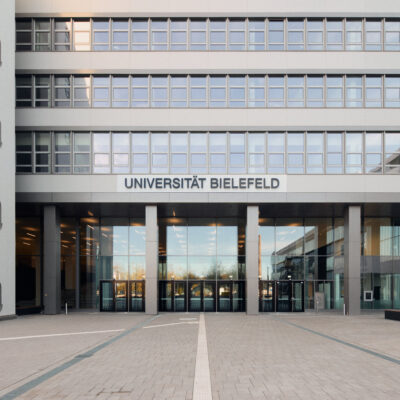Chemical reactions often do not take place by themselves, but require catalysts—chemical and biological. Up to now, these have typically been used separately. This requires complex separation stages when processing the respective products, and it results in high solvent consumption and corresponding amounts of waste. Using such processes produces millions of tonnes of industrial chemicals every year.
Chemist Professor Dr Harald Gröger from Bielefeld University is a pioneer in the field of what is known as one-pot chemoenzymatic synthesis. This concept describes several sequential reactions carried out in a single reaction vessel without separation stages using a combination of conventional chemocatalysts and environmentally friendly biocatalysts (enzymes). This one-pot procedure makes production processes more efficient and reduces waste. Together with colleagues from the US University of California, Santa Barbara and from the Swiss pharmaceutical company Novartis, Gröger has published a paper on such efficient syntheses in the journal Chemical Reviews.

© Bielefeld University/Michael Adamski
Gröger’s research group specializes in combining biocatalysts and chemocatalysts. Biocatalysts are found in nature in the form of enzymes, whereas chemocatalysts are produced artificially. If both catalysts are to function in a single reaction vessel, they need a common reaction medium. For Gröger and his colleagues, the solution to this is water: ‘Water is cheap, available in large quantities, and environmentally friendly,’ says the chemist.
But there are challenges in this: whereas most enzymes need water in any case to trigger reactions, chemocatalysts are routinely used in organic solvents. However, such solvents as ethers or alkanes can deactivate enzymes. ‘But if we could manage to stay with water, we would, in principle, be able to use all existing enzymes. In principle, this would mean that we could use the whole spectrum of enzymes in nature and thus save energy and reduce waste.’
Combining different approaches
To make this work, the three scientists are taking a two-pronged approach: ‘We have to get enzymes to convert unnatural starting materials in a highly productive way. To some extent, we do this by also changing the structure of the enzymes and the DNA of the microorganisms that produce them. However, we also need to design chemical catalysts that are able to conduct reactions in water.’ Combining the two types of catalysts results in further challenges: namely, the need to avoid unwanted additional reaction pathways—for example, when a chemical catalyst decomposes the product of the subsequent biotransformation.
The authors use their review to summarize their research findings with those of the numerous research groups now active in this field: ‘It was exciting to jointly prepare this publication as a trio,’ says Gröger. This is because he did not know the two colleagues personally before, and they each have different approaches. Professor Dr Bruce H. Lipshutz from the University of California, Santa Barbara, has spent years on research in the field of chemical synthesis in water. Dr Fabrice Gallou is an industrial chemist at the pharmaceutical company Novartis in Switzerland and works on making catalysis processes compatible for industry.

© Bielefeld University/Michael Adamski
Green chemistry from the feedstock onwards
The one-pot synthesis approach is in accordance with the principles of green chemistry, a field of research that has gained particular attention in recent years. ‘Industry’s interest in sustainable production is growing and, with it, the number of researchers,’ says Gröger. The concept aims to minimize the environmental impact of chemical processes and products. However, it doesn’t stop at optimizing processes: ‘Although research on one-pot synthesis in water can improve the efficiency and sustainability of manufacturing processes, I still haven’t solved the issue of how to replace conventional feedstocks gained from fossil sources.’ Crude oil currently forms the basis of many everyday products, while simultaneously making a massive contribution to climate change. ‘With renewable feedstocks, we can significantly reduce our CO2 footprint while also designing new materials,’ says the scientist, thereby describing a second major area of his research work at Bielefeld University.
Together with the Munich-based company Klüber Lubrication, a group of Bielefeld chemists led by Gröger have developed new lubricants particularly for marine applications. ‘In harbour basins, boats lie close together and pollute the water with non-degradable oils.’ Using a process that combines chemical and enzymatic substance conversions, lubricants have been designed in the laboratory that can be accessed through renewable feedstocks while simultaneously being more biodegradable. In another cooperation with the Hamburg University of Technology and the chemical company BASF in Ludwigshafen, scientists from the Gröger work group are developing bio-plasticizers that use, for example, bran from food production waste streams as their feedstock instead of petroleum.

© Bielefeld University/Michael Adamski
Opening up new production processes through biotechnology
Harald Gröger has been carrying out research on combining chemical and enzymatic processes for almost two decades. For a long time, he worked in the chemical industry where he first came into contact with the field of biotechnology. ‘Colleagues kept asking me what is better: biocatalysis or chemocatalysis. Although I found this to be a justified question, it was also an uncomfortable one, because I enjoy working in both fields. Now I’m interested in bringing together the best of both worlds.’
Today, biotechnology is gaining ground as an efficient production technology, especially in the pharmaceutical sector. However, there are limitations: ‘It is easier for large industrial companies to engage in biotechnology because this requires a more extensive, interdisciplinary research infrastructure that is often not available to smaller companies,’ says Gröger. ‘Therefore, the further spread of biotechnology in the industrial landscape will also depend on how well small and medium-sized companies gain access to biotechnology in the future. In any case, the prospects for sustainable industrial applications are enormous.’





